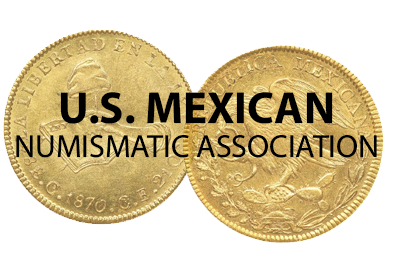Gold coins of the Pre-Columbian Collections
Each collection had three gold coins of a single design, in weights of ¼. ½ and 1 ounce.
The Aztec Collection
Jaguar / Stone of the Suns
The Aztec creation myth held that, prior to the current epoch, the earth experienced four others, each with a new incarnation of the sun god. The first age was “Nahui Ocelotl” represented by the head of a jaguar and four large dots representing the number four (only three remain on the fragment shown). The relief sculpture from which the design is taken is housed in the National Museum of Anthropology. The symbol in the border is a circle enclosing a pair of crossed vertical and horizontal band, as depicted on the Stone of Moctezuma I.
This design was issued in 1992 only, in Brilliant Uncirculated and Proof, in three weights: ¼ ounce (denominated 250 pesos), ½ ounce (500 pesos) and 1 ounce (1,000 pesos).
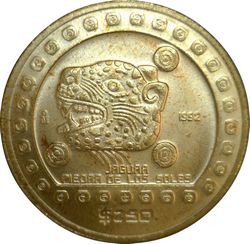
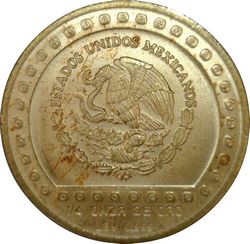
KM-558 1992 ¼ oz gold, $250
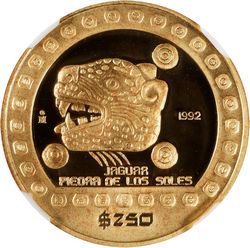
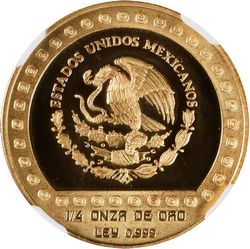
KM-558 1992 ¼ oz gold, $250 Proof (Stack’s-Bowers auction, November 2023, lot 72286)
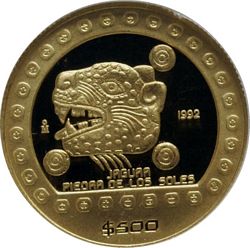
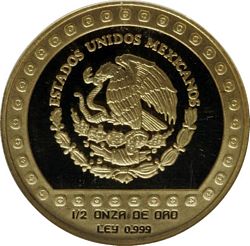
KM-559 1992 ½ oz gold, $500

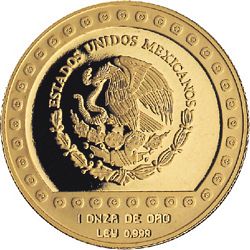
KM-560 1992 1 oz gold, $1,000
The Central Veracruz Collection
Hacha Ceremonial
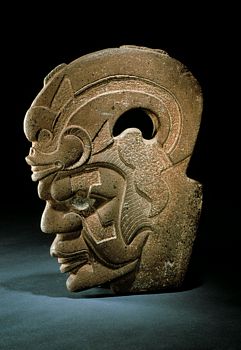 This Hacha Ceremonial (Ceremonial Hatchet), in the National Museum of Anthropology, is modelled after the head of a man, flattened in profile, and wearing a helmet that is probably associated with the juego de pelota. The coin’s border is based on patterns in the bas-reliefs found in the El Tajín zone.
This Hacha Ceremonial (Ceremonial Hatchet), in the National Museum of Anthropology, is modelled after the head of a man, flattened in profile, and wearing a helmet that is probably associated with the juego de pelota. The coin’s border is based on patterns in the bas-reliefs found in the El Tajín zone.
This design was issued in 1993 in both Brilliant Uncirculated and Proof, in three weights: ¼ ounce (denominated 25 new pesos), ½ ounce (50 new pesos) and 1 ounce (100 new pesos).
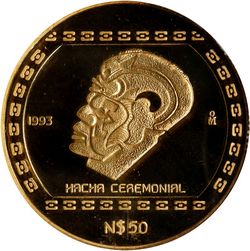

KM-586 1993 ½ oz gold, $50 New pesos (Stack’s-Bowers Hong Kong auction, 22 April 2023, lot 44067)
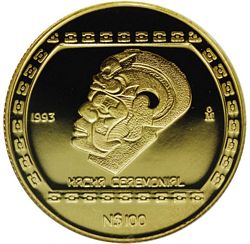
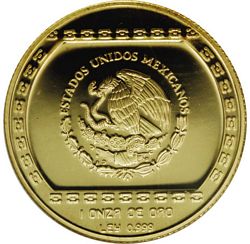
KM-587 1993 1 oz gold, $100 New pesos
The Mayan Collection
Personaje de Jaina
The design is based on the small, naturalistic terracotta figurines sculptured by the Mayans. Thousands have been found on the small island of Jaina, which was used by the Mayans of Yucatán as a burial ground during the third and fourth centuries. Although many more have been found elsewhere, they are commonly known as Jaina figurines. The one reproduced on the coin depicts a civil dignitary sitting on a throne, and is part of the collection of the National Museum of Anthropology. The border design is inspired by Mayan glyphs.
This design was issued in 1994 in both Brilliant Uncirculated and Proof, in three weights: ¼ ounce (denominated 25 new pesos), ½ ounce (50 new pesos) and 1 ounce (100 new pesos).
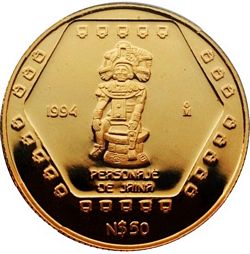
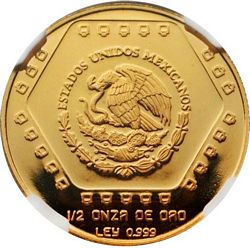
KM-580 1994 ½ oz gold, $50 New pesos
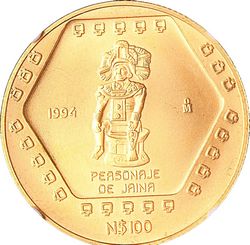
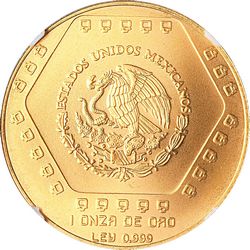
KM-581 1994 ½ oz gold, $100 New pesos
The Olmec Collection
Sacerdote
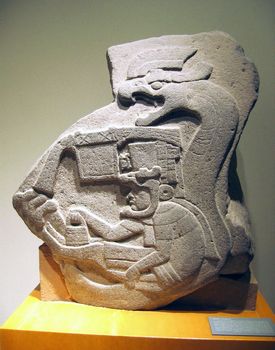 The Sacerdote (Priest) is a bas-relief figure found at the ancient ruins of La Venta and now located in the National Museum of Anthropology. In the sculpture, a priest or high dignitary is seated in profile, and is surrounded by a massive, undulating feathered serpent. The element repeated in the coin’s border is based on a device in the headband of the Jaguar Man.
The Sacerdote (Priest) is a bas-relief figure found at the ancient ruins of La Venta and now located in the National Museum of Anthropology. In the sculpture, a priest or high dignitary is seated in profile, and is surrounded by a massive, undulating feathered serpent. The element repeated in the coin’s border is based on a device in the headband of the Jaguar Man.
This design was issued in 1996 in both Brilliant Uncirculated and Proof, in three weights: ¼ ounce (denominated 25 pesos), ½ ounce (50 pesos) and 1 ounce (100 pesos). These weights were issued again in 1998, in Brilliant Uncirculated only.
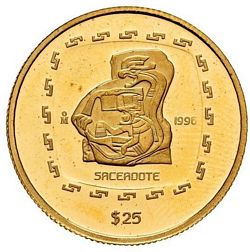
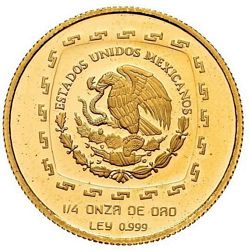
KM-600 1996 ¼ oz gold, $25
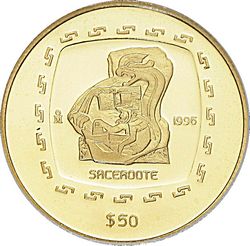

KM-601 1996 ½ oz gold, $50
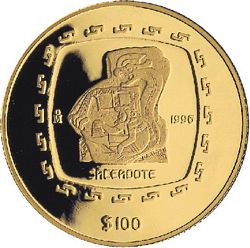
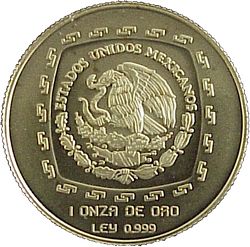
KM-602 1996 1 oz gold, $100
The Teotihuacán Collection
Serpiente Emplumada
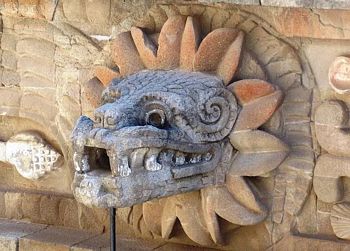 The Serpiente Emplumada (Feathered Serpent) was one of the most powerful of the Teotihuacán culture, and the subject of special rituals. Dualism is common in Mesoamerican deities, as shown here with the feathered serpent. Being a serpent represents the human aspect of it, and the ability to move on the ground like and among other animals. Being feathered represents the divine nature of it, or the ability to reach the skies. The repeated element in the coin’s border is based on a design found in an image of the goddess Chalchuihtlicue.
The Serpiente Emplumada (Feathered Serpent) was one of the most powerful of the Teotihuacán culture, and the subject of special rituals. Dualism is common in Mesoamerican deities, as shown here with the feathered serpent. Being a serpent represents the human aspect of it, and the ability to move on the ground like and among other animals. Being feathered represents the divine nature of it, or the ability to reach the skies. The repeated element in the coin’s border is based on a design found in an image of the goddess Chalchuihtlicue.
This design was issued in 1997 in both Brilliant Uncirculated and Proof, in three weights: ¼ ounce (denominated 25 pesos), ½ ounce (50 pesos) and 1 ounce (100 pesos). These weights were issued again in 1998, in Brilliant Uncirculated only.
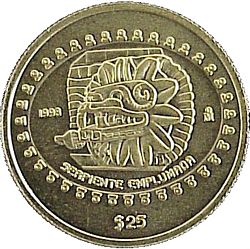
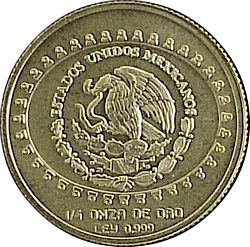
KM-624 1998 ¼ oz gold, $25
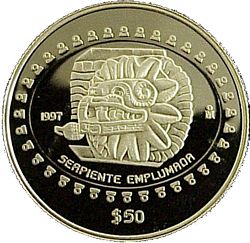
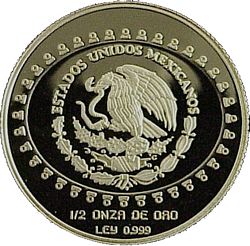
KM-625 1997 ½ oz gold, $50
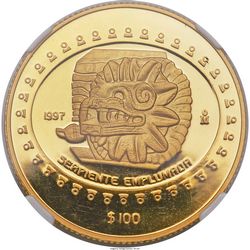
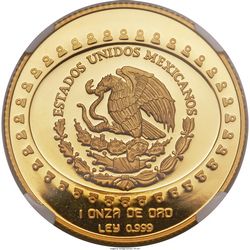
KM-626 1997 1 oz gold, $100
The Toltec Collection
Aguila
The Aguila (Eagle) design is based on a bas-relief at the Tula site: an eagle devouring a human heart.
The encircling border is based on an ornament found on the arm of a Chaac-Mool.
Gold coins was issued in 1998 in both Brilliant Uncirculated and Proof, in three weights: ¼ ounce (denominated 25 pesos), ½ ounce (50 pesos) and 1 ounce (100 pesos).
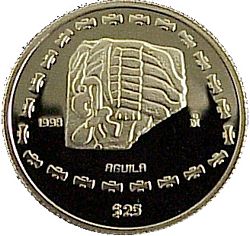
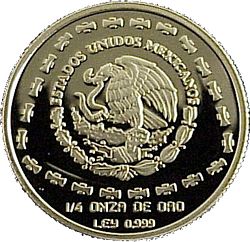
KM-667 1998 ¼ oz gold, $25
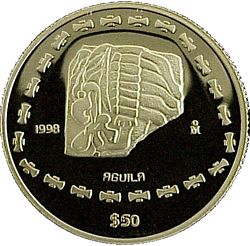
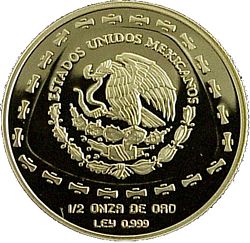
KM-668 1998 ½ oz gold, $50
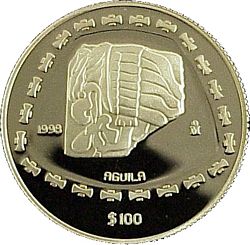

KM-669 1998 1 oz gold, $100
